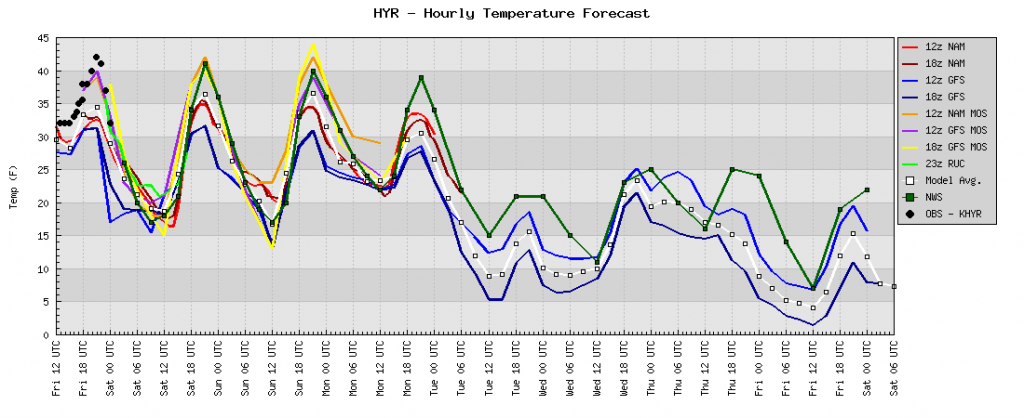This will be the first of many features speculating about the weather upcoming and how it will affect the Birkie. It is all wild speculation, so take it with a grain of salt. Thanks.
What’s the weather? For those of us who get a little too worked up about the Birkie (raise your hands), and especially those of us who are paying a lot of money for plane tickets, this will be a frequent question over the next three weeks. The race is twenty-two days away, and the models only go out sixteen, so there’s no idea of what might be coming down the pike. But, we’re here to speculate wildly! So we will.

Model print out for Hayward. More information on where to find this model data can be found below.
I mentioned recently that the last week before the race was, in low snow years, make-or-break. This year that may be the case, but the next few days will be pretty important, too. This is because it’s warm in Hayward. Not 50-degrees sweltering hot (which is rare, but not out of the question) but peaking in to the low 40s every day. In late December, that would be a nuisance. But in February, with the sun higher in the sky and getting higher every day, it’s more of a problem. Reports are coming in that some hills are getting thin, as would be expected. I’d assume the Birkie will have a large team out to shovel the hills. So if it hits 42 the next three days (and keeps freezing hard each night) we’re probably safe.
The issue would be losing the base completely. If that were to happen, and for that we’d need several days above freezing, or some rain, or something similarly awful, there would be major issues. The Birkie Trail is grassy and smooth enough that with any base, a couple of inches of new snow can take you from a 2007 rockskivaganza to a picture-perfect race. If you lose that base, however, three inches is not enough to groom and have 8000 skiers glide across it, V1 up and it snowplow it off the hills. If we lose the base, the bar to have a race goes a lot—several inches—higher.
For now we can’t speculate on the last week. Beyond this week, where the base should hold (mostly) we’re probably going to be okay. The long range appears that it will stay cooler, but there is not any big snow on the horizon. Six or eight inches would be great. But it hasn’t been that sort of winter. Yet.
A couple of resources:
The Bufkit Warehouse Meteogram for HYR. A great resource (and the source of the image above) showing, graphically, temperature, snowfall and other such fun things for all the NOAA models. Updated pretty continuously. New NAM (84 hour) models come out at 3 and 9 central, new GFS at 5 and 11. Or a few minutes after. This site was built by a grad student at Iowa State. Who said nothing good comes from Iowa?!
The sixteen day GFS model printout. Also updated at 5 and 11. This shows temperatures and precipitation (but not snow) for 384 hours, or sixteen days. This will hit race day in about a week, but the second week out is really volatile, so take everything with a shaker of salt.

